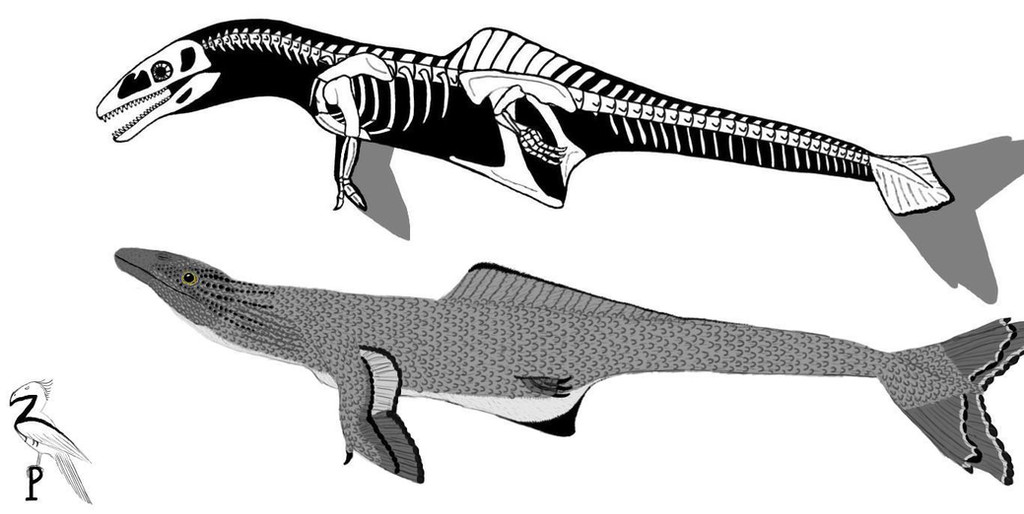HOME | DD
 ZoPteryx — Ornithocetids
ZoPteryx — Ornithocetids

Published: 2014-03-26 21:16:03 +0000 UTC; Views: 17664; Favourites: 262; Downloads: 46
Redirect to original
Description
Quite possibly the most derived archosaurs that have ever lived, the discovery of cetacean-like dinosaurs in the Saurocene shocked the scientific community. Though scientists were initially cautious to classify them, genetic and skeletal evidence has made it abundantly clear that the ornithocetids are nested well within the aquaraptoriformes along with the better known aquaraptorids. Ornithocetids emerged in the late Oligocene and quickly spread across the world's oceans, filling the gap left by the sudden disappearance of many large marine reptiles in the late Eocene, including other more archaic types of aquaraptoriformes.Skeletally, ornithocetids are highly abnormal, much more so than the aquaraptorids. There bones are thick-walled and relatively solid; the naris and antorbital fenestra have combined into a nasoantorbital fenestra (similar to some pterosaurs) to accommodate the retracted nostrils; digits II and III of the hand are completely fused and usually clawless; the pubis and ischium are massively constructed and elongated to form a keel along the underside; the dorsal spines of the sacral vertebrae are elongated and often form a dorsal fin; the hind limbs are extremely reduced, but still functional; the hallux is vestigial and, unusually, lies on the outer side of the foot; and finally the last few caudal vertebrae have fused into a massive pygostyle to support the feathered tail fluke.
Physiologically, their most peculiar feature, the one that sets them apart from all other archosaurs, is their ability to give live birth. They are ovoviviparous, meaning the hard-shelled eggs are retained inside the mothers body but there is little to no connection between them and the mother. The egg shells dissolve away and are excreted shortly before the young are due to be born. Dissected specimens have allowed scientists to determine that, for most species, eggs are rather large and usually number between 5 and 10. Young stay with their mothers for an extended period of time, though how long various between genera with some becoming independent at only a few months old, while others may remain with their family group for years. There is a high mortality rate amongst newborns.
Locomotion is a simple cetacean-like undulation of the body and tail, occasionally accompanied by flapping with the forelimbs. Their most flexible points are their necks and the base of the tail, unlike aquaraptorids which also have a flexible lower back. Like all aquaraptoriformes, the feathers of the forelimbs and tail are unique, stiff, interlocking, and plate-like. The feathers that form the tail fluke are fixed in position, but those of the arm are a bit looser allowing the arm to flex normally, this lends them great maneuverability. These feathers are also detachable and may be shed at will (such as when they have been grasped by a predator!), similar to how some lizards can drop their tails; like the lizards' tail, the feathers will regenerate in time.
Though webbed, the tiny hind limbs serve no purpose in locomotion and are used mainly during mating, hence their large claws. In receptive females, the feet may become brightly colored to advertise to the males. Ornithocetids rely mainly on sight and sound, though they do not use any form of echolocation. The gular pouches of males can become brightly colored in the breeding season and extended like the dewlap of anole to display to females and rivals. Most species are rather social and some even form large flocks. They are fairly large creature, on average being about 4-5 meters long and weighing over 700 pounds; some are much larger, while others are smaller. Behaviorally, they are quite similar to cetaceans in habits, but not in intelligence.
There are four genera: Ornithocetus (O. callipeplus is pictured), Pelagisaurus, Ichthyoraptor, and the peculiar Mantaraptor. Small examples have been maintained in captivity, but they are nervous animals that must be given lots of space. The tank must also be covered, otherwise they will attempt to jump out (being stranded on land, via jumping out of tank or beaching themselves, almost always leads to a broken pelvis and certain death). Large individuals in the wild should be treated with caution, they are very inquisitive, sometimes too inquisitive.
.....................................................................................................................................................................................................
Sorry about all that text, genera descriptions will come next time.
Ornithocetid Genera
Aquaraptoriformes Intro
Saurocene Intro
Related content
Comments: 65

Nice work, this looks pretty plausible.
👍: 0 ⏩: 1

Ornithocetids? So that would be...bird-whales? This concept shouldn't work, but it does...
👍: 0 ⏩: 1

Damn... quite like something in my world. Hopefully when I present mine they won't be too alike. Great work.
👍: 0 ⏩: 1

Thanks! Great minds think alike!
👍: 0 ⏩: 0































